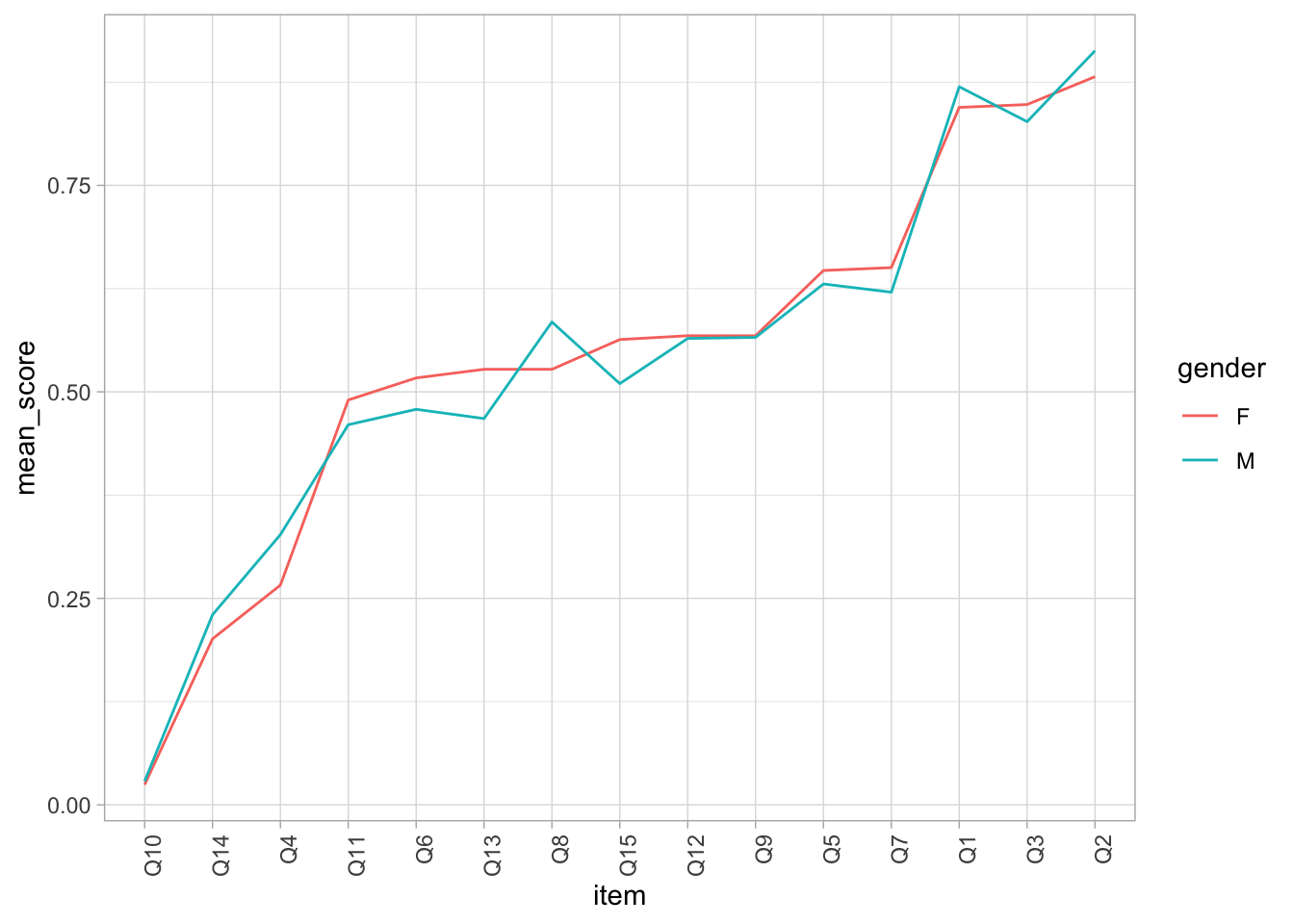rm(list=ls())
library(tidyverse)
library(dexter)
# load in the dataset
responses <- read_csv('data/maths/responses.csv')
responses <- responses %>% filter(!is.na(gender))
keys <- read_csv('data/maths/key.csv')
# Create the rules
rules <- keys_to_rules(keys, include_NA_rule = TRUE)
db <- start_new_project(rules, db_name = ":memory:", person_properties=list(gender=""))
# Add item properties
properties <- read_csv('data/maths/properties.csv')
add_item_properties(db, item_properties = properties, default_values = NULL)
add_booklet(db, responses, "maths-workshop")
#| label: tbl-test
#| tbl-cap: Test statistics
# check the number of items, the persons and the max score
get_booklets(db)
knitr::kable(get_booklets(db), digits = 2)
# get the item scores for later use in other packages
item_scores <- get_resp_matrix(db)
item_scores <- as_tibble(item_scores)
item_scores <- item_scores %>% select(
Q1,
Q2,
Q3,
Q4,
Q5,
Q6,
Q7,
Q8,
Q9,
Q10,
Q11,
Q12,
Q13,
Q14,
Q15
)23 Workshop 2 Answers
23.1 Summary item analysis
# produce the item tables
tt = tia_tables(db)
knitr::kable(tt$booklets, digits = 2)
## save the output so you can open it in Excel
write_csv(tt$booklets, file='tables/booklets.csv')| booklet_id | n_items | alpha | mean_pvalue | mean_rit | mean_rir | max_booklet_score | n_persons |
|---|---|---|---|---|---|---|---|
| maths-workshop | 15 | 0.73 | 0.54 | 0.44 | 0.32 | 15 | 1665 |
23.2 Item descriptive stats
# get the item descriptive stats
knitr::kable(tt$items, digits = 2)
## save the output so you can open it in Excel
write_csv(tt$items, file='tables/items.csv')| booklet_id | item_id | mean_score | sd_score | max_score | pvalue | rit | rir | n_persons |
|---|---|---|---|---|---|---|---|---|
| maths-workshop | Q1 | 0.86 | 0.35 | 1 | 0.86 | 0.44 | 0.34 | 1665 |
| maths-workshop | Q10 | 0.03 | 0.16 | 1 | 0.03 | -0.05 | -0.10 | 1665 |
| maths-workshop | Q11 | 0.48 | 0.50 | 1 | 0.48 | 0.63 | 0.51 | 1665 |
| maths-workshop | Q12 | 0.57 | 0.50 | 1 | 0.57 | 0.52 | 0.39 | 1665 |
| maths-workshop | Q13 | 0.50 | 0.50 | 1 | 0.50 | 0.53 | 0.40 | 1665 |
| maths-workshop | Q14 | 0.22 | 0.41 | 1 | 0.22 | 0.31 | 0.18 | 1665 |
| maths-workshop | Q15 | 0.54 | 0.50 | 1 | 0.54 | 0.59 | 0.47 | 1665 |
| maths-workshop | Q2 | 0.90 | 0.30 | 1 | 0.90 | 0.41 | 0.32 | 1665 |
| maths-workshop | Q3 | 0.84 | 0.37 | 1 | 0.84 | 0.48 | 0.37 | 1665 |
| maths-workshop | Q4 | 0.30 | 0.46 | 1 | 0.30 | 0.37 | 0.23 | 1665 |
| maths-workshop | Q5 | 0.64 | 0.48 | 1 | 0.64 | 0.51 | 0.37 | 1665 |
| maths-workshop | Q6 | 0.50 | 0.50 | 1 | 0.50 | 0.40 | 0.24 | 1665 |
| maths-workshop | Q7 | 0.64 | 0.48 | 1 | 0.64 | 0.51 | 0.38 | 1665 |
| maths-workshop | Q8 | 0.55 | 0.50 | 1 | 0.55 | 0.49 | 0.35 | 1665 |
| maths-workshop | Q9 | 0.57 | 0.50 | 1 | 0.57 | 0.47 | 0.33 | 1665 |
23.3 Distractor analysis
# Look at all the distractor plots
n_items <- nrow(keys)
for(i in 1:n_items){
distractor_plot(db, keys$item_id[i])
}
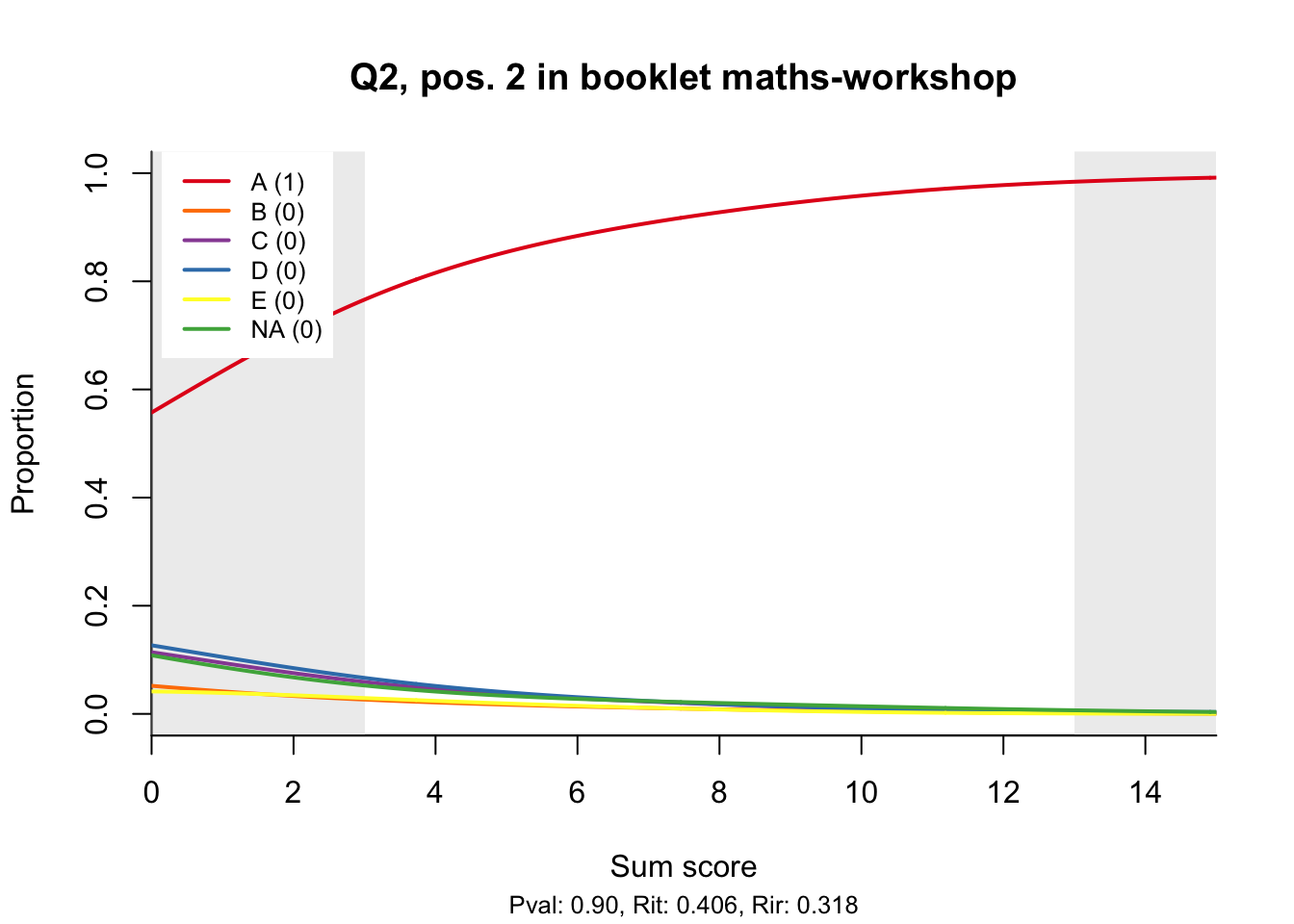
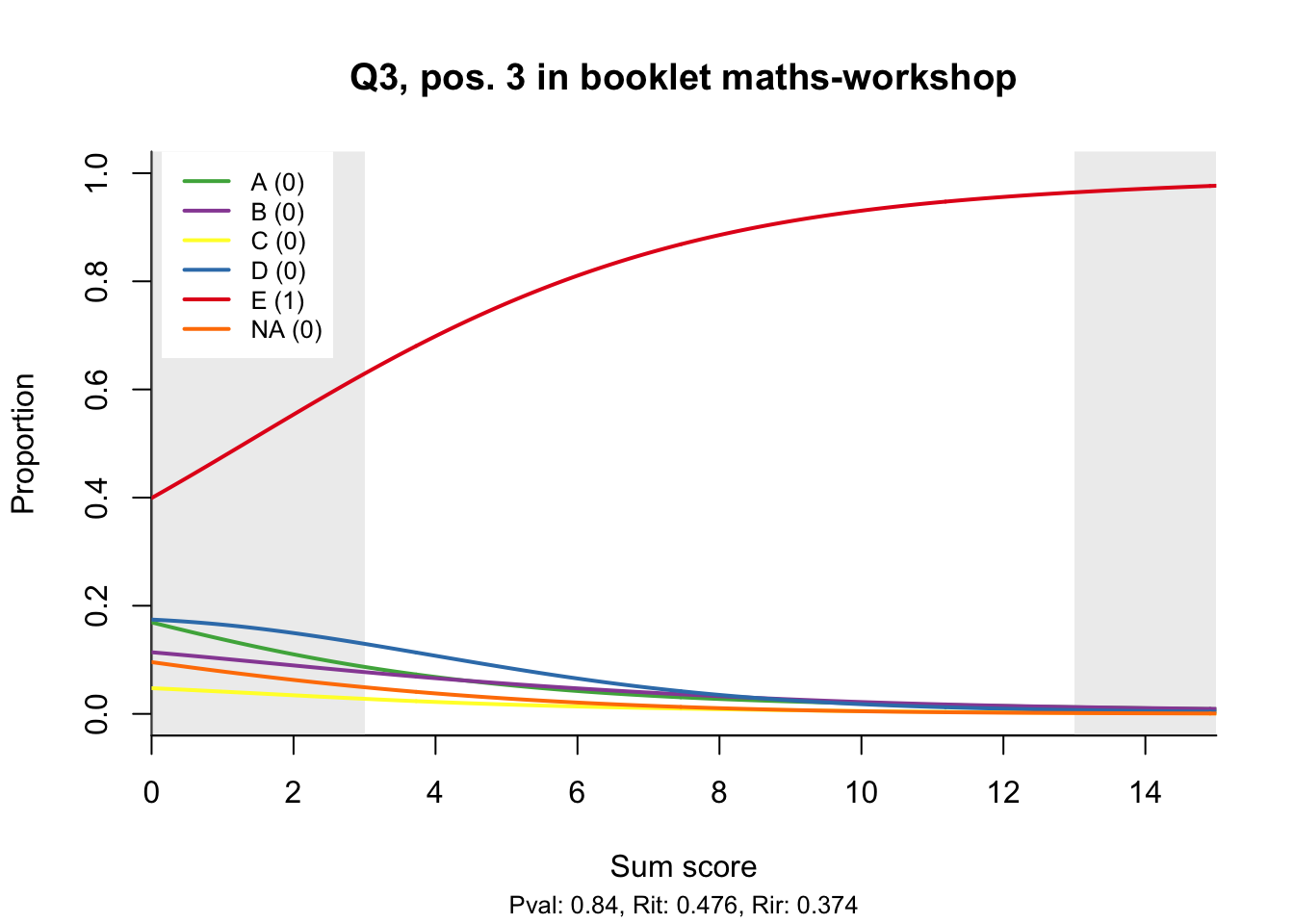
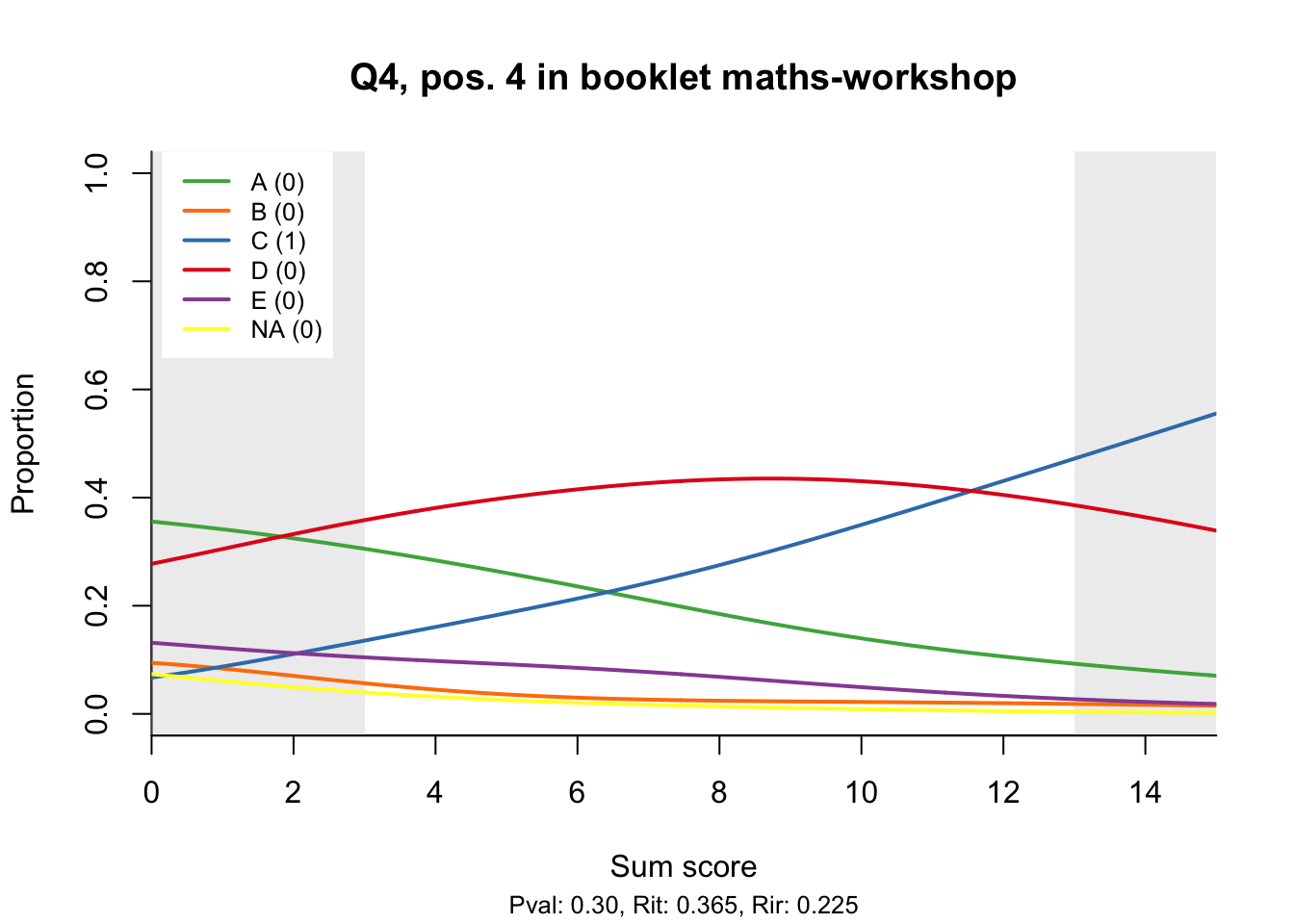
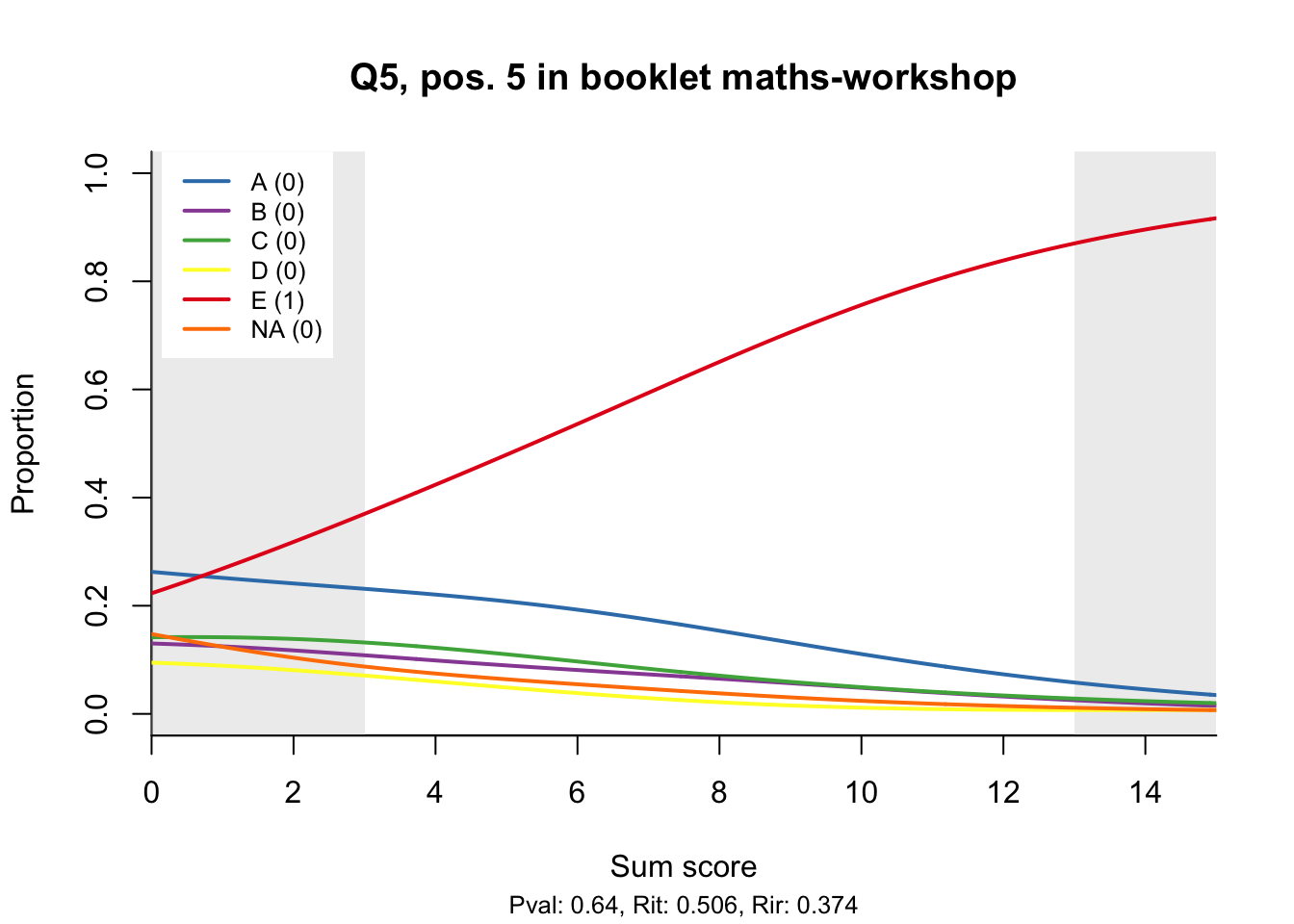
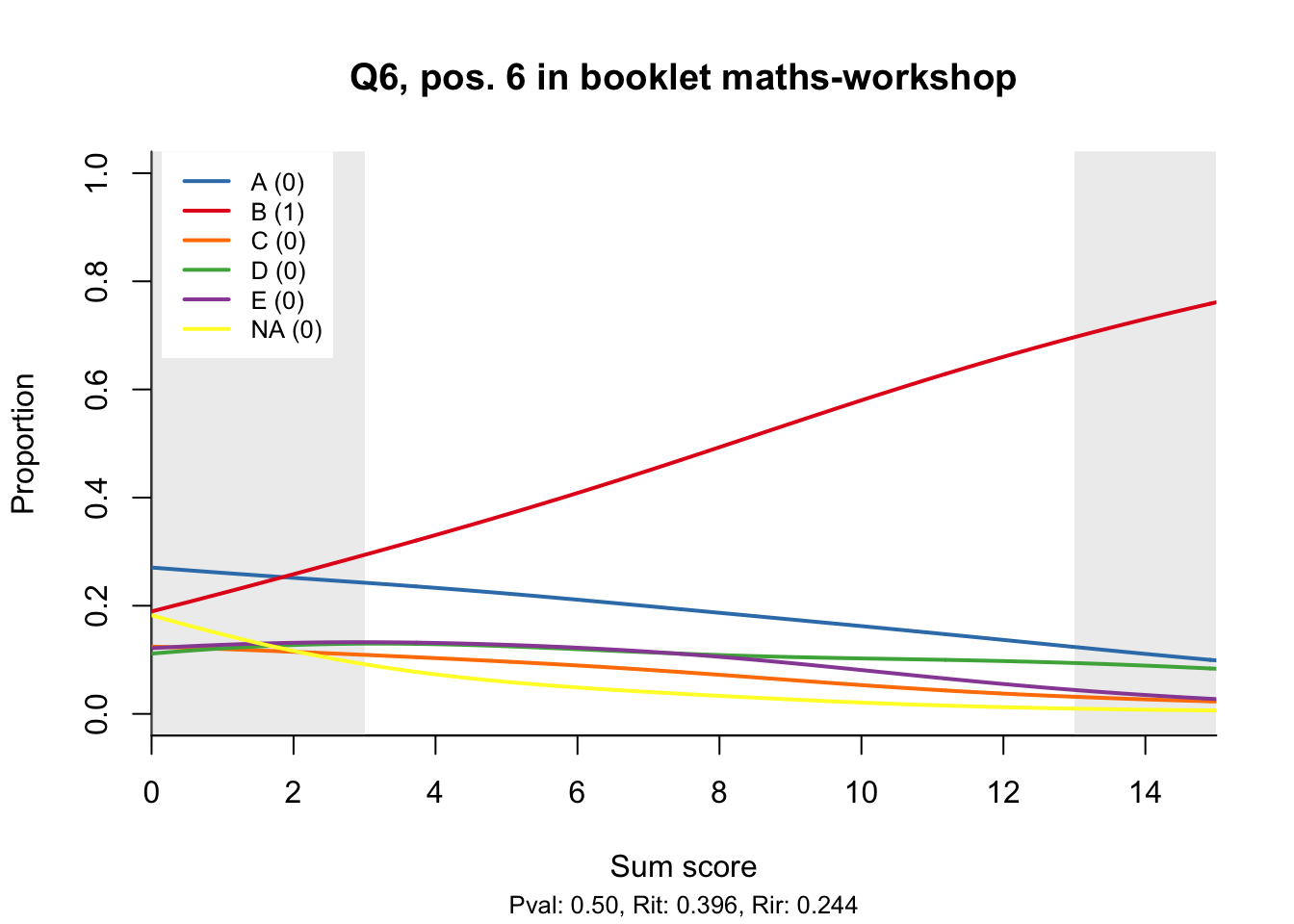

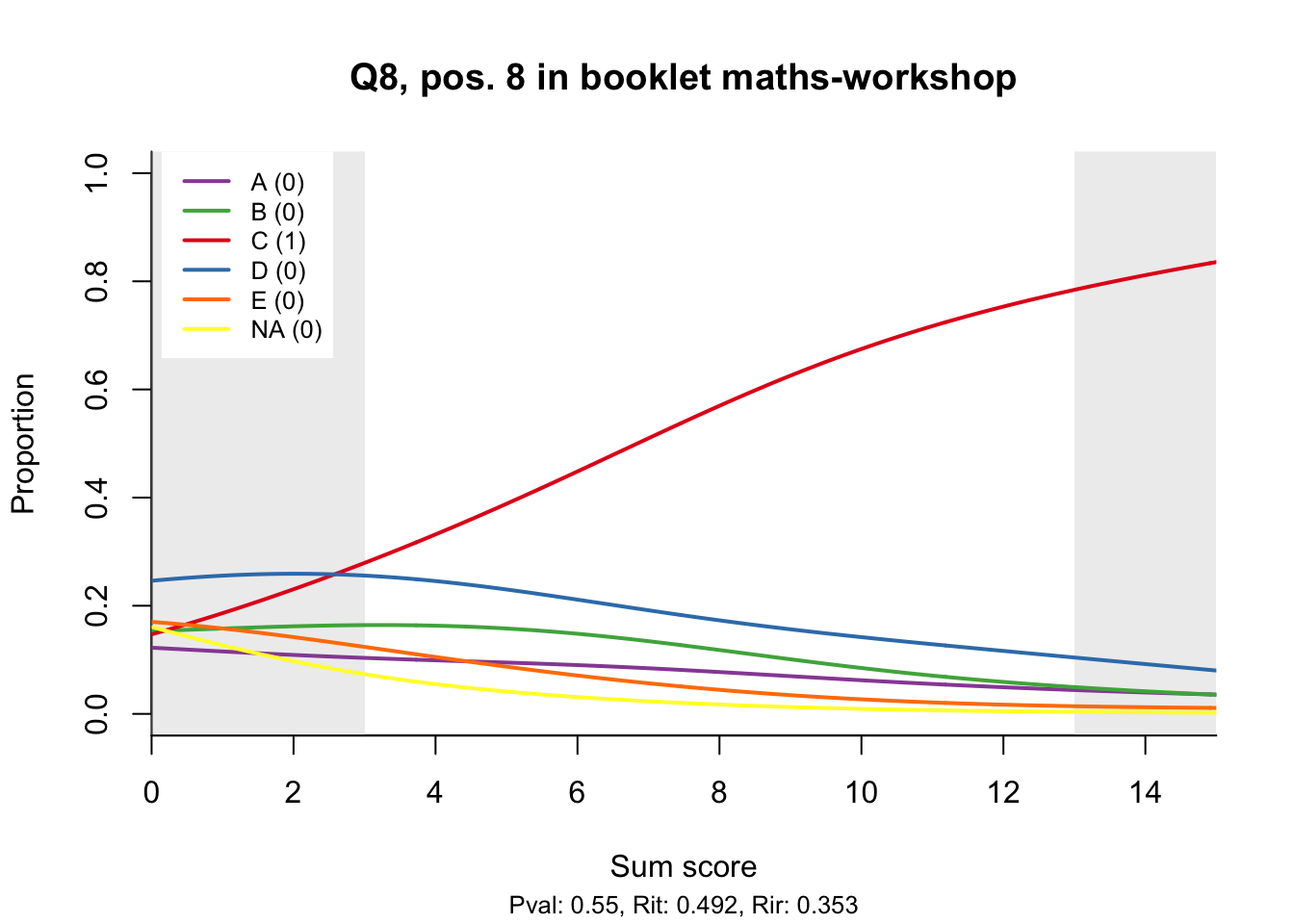


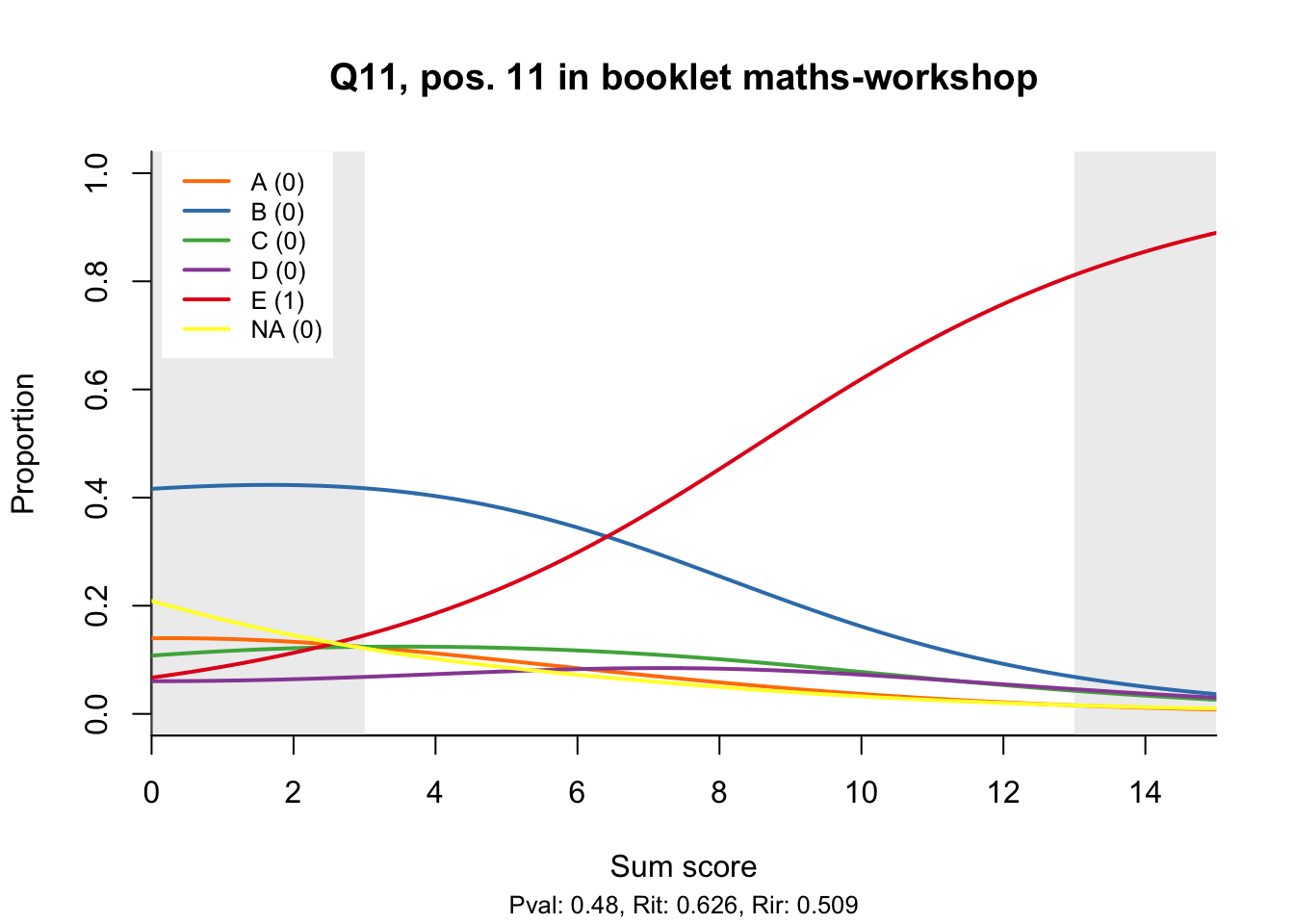
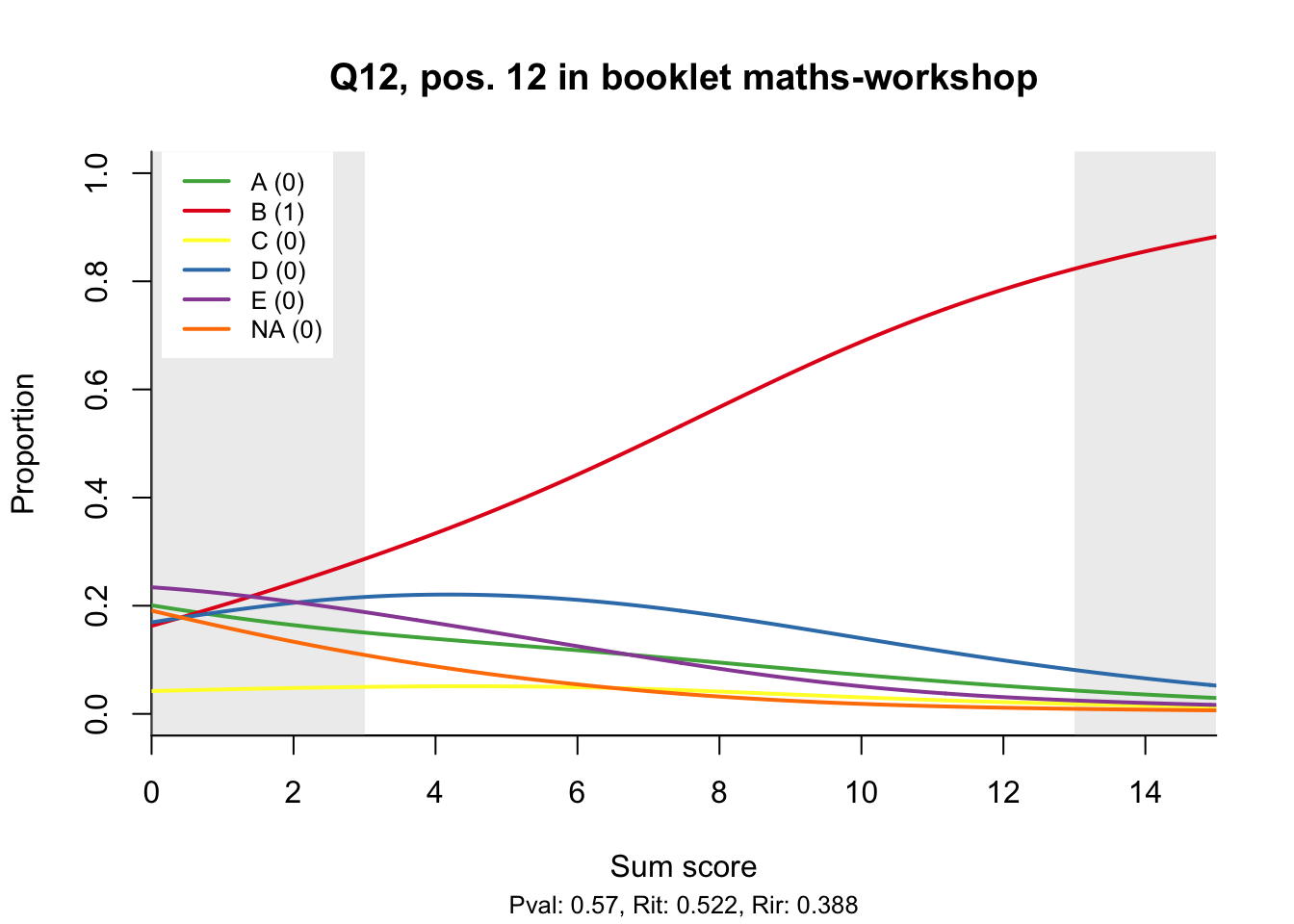
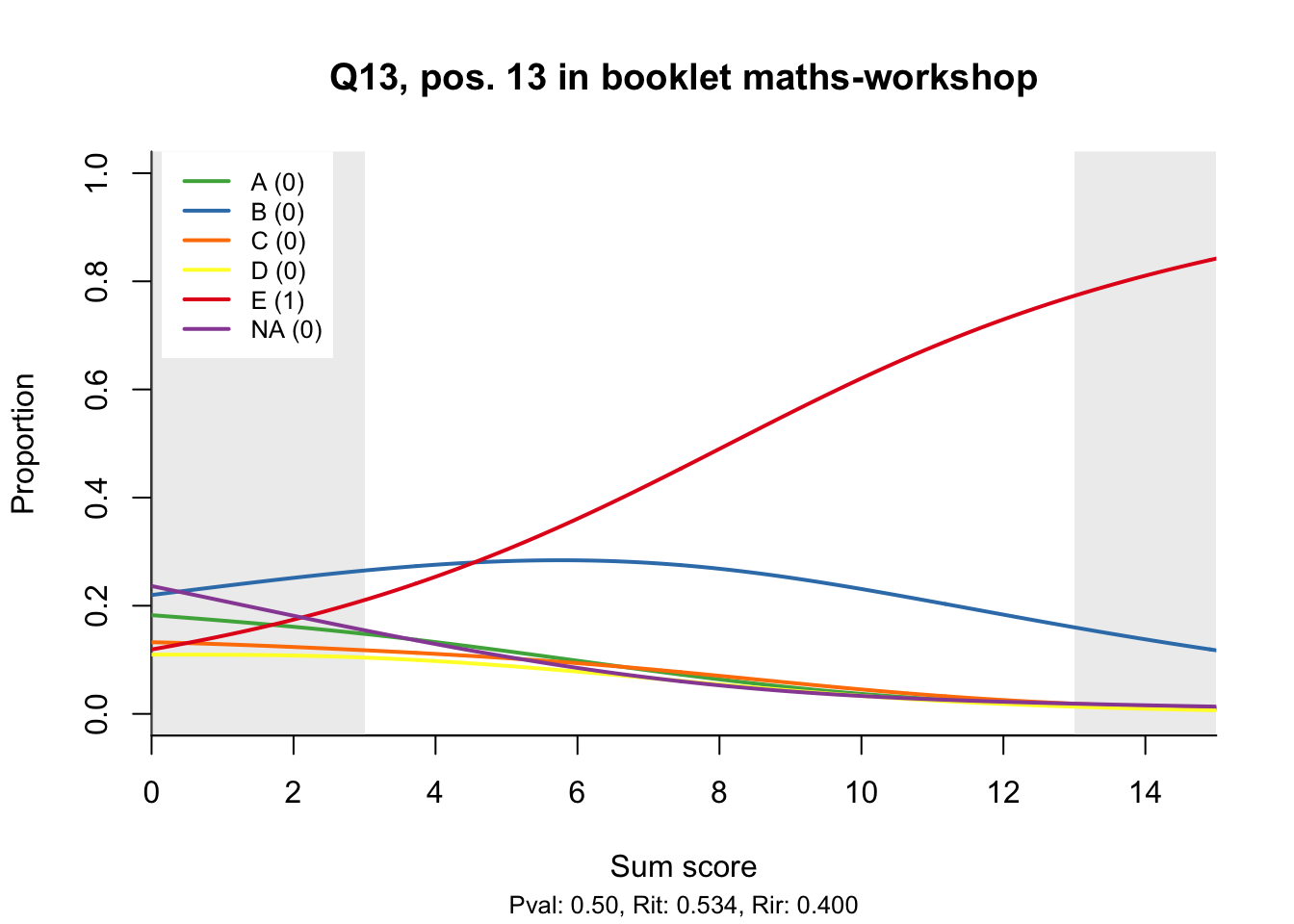
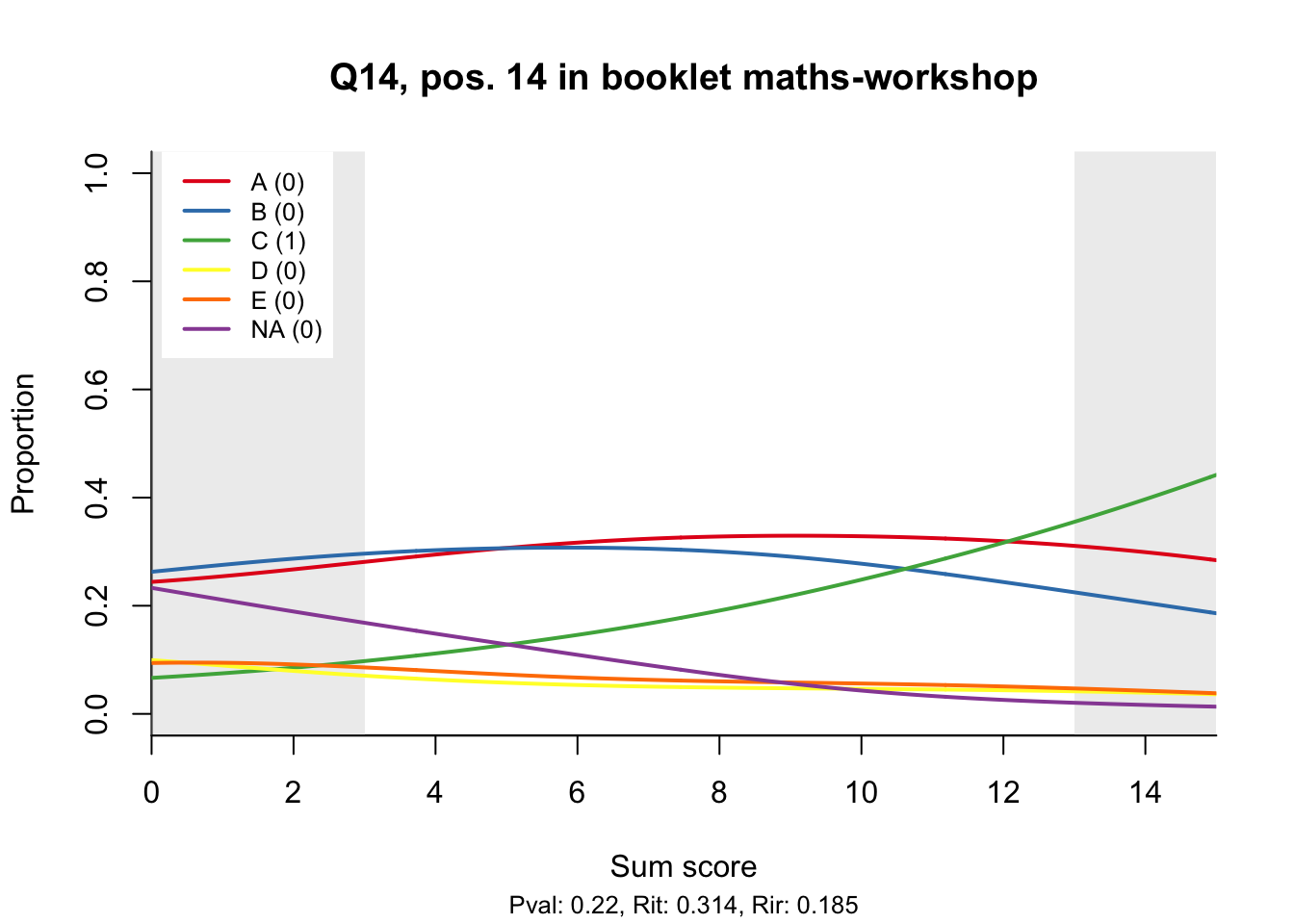

The item test correlations in Table 23.2 suggest an issue with item 10. Let’s look at the distractor plot for that item Figure 23.1.
# produce the distractor plots
# Look at distractor plots for all items
# Something is odd about Q10, so let's look at the distractor plot for that item
distractor_plot(db, 'Q10')Warning: In density.default(bkl_scores$booklet_score, n = 512, weights = bkl_scores$n/N,
adjust = adjust, from = 0, to = max(bkl_scores$booklet_score),
warnWbw = FALSE) :
extra argument 'warnWbw' will be disregardedWarning: In density.default(.$booklet_score, weights = .$n/sum(.$n), n = 512,
bw = dAll$bw, from = min(dAll$x), to = max(dAll$x), warnWbw = FALSE) :
extra argument 'warnWbw' will be disregarded
Warning: In density.default(.$booklet_score, weights = .$n/sum(.$n), n = 512,
bw = dAll$bw, from = min(dAll$x), to = max(dAll$x), warnWbw = FALSE) :
extra argument 'warnWbw' will be disregarded
Warning: In density.default(.$booklet_score, weights = .$n/sum(.$n), n = 512,
bw = dAll$bw, from = min(dAll$x), to = max(dAll$x), warnWbw = FALSE) :
extra argument 'warnWbw' will be disregarded
Warning: In density.default(.$booklet_score, weights = .$n/sum(.$n), n = 512,
bw = dAll$bw, from = min(dAll$x), to = max(dAll$x), warnWbw = FALSE) :
extra argument 'warnWbw' will be disregarded
Warning: In density.default(.$booklet_score, weights = .$n/sum(.$n), n = 512,
bw = dAll$bw, from = min(dAll$x), to = max(dAll$x), warnWbw = FALSE) :
extra argument 'warnWbw' will be disregarded
Warning: In density.default(.$booklet_score, weights = .$n/sum(.$n), n = 512,
bw = dAll$bw, from = min(dAll$x), to = max(dAll$x), warnWbw = FALSE) :
extra argument 'warnWbw' will be disregarded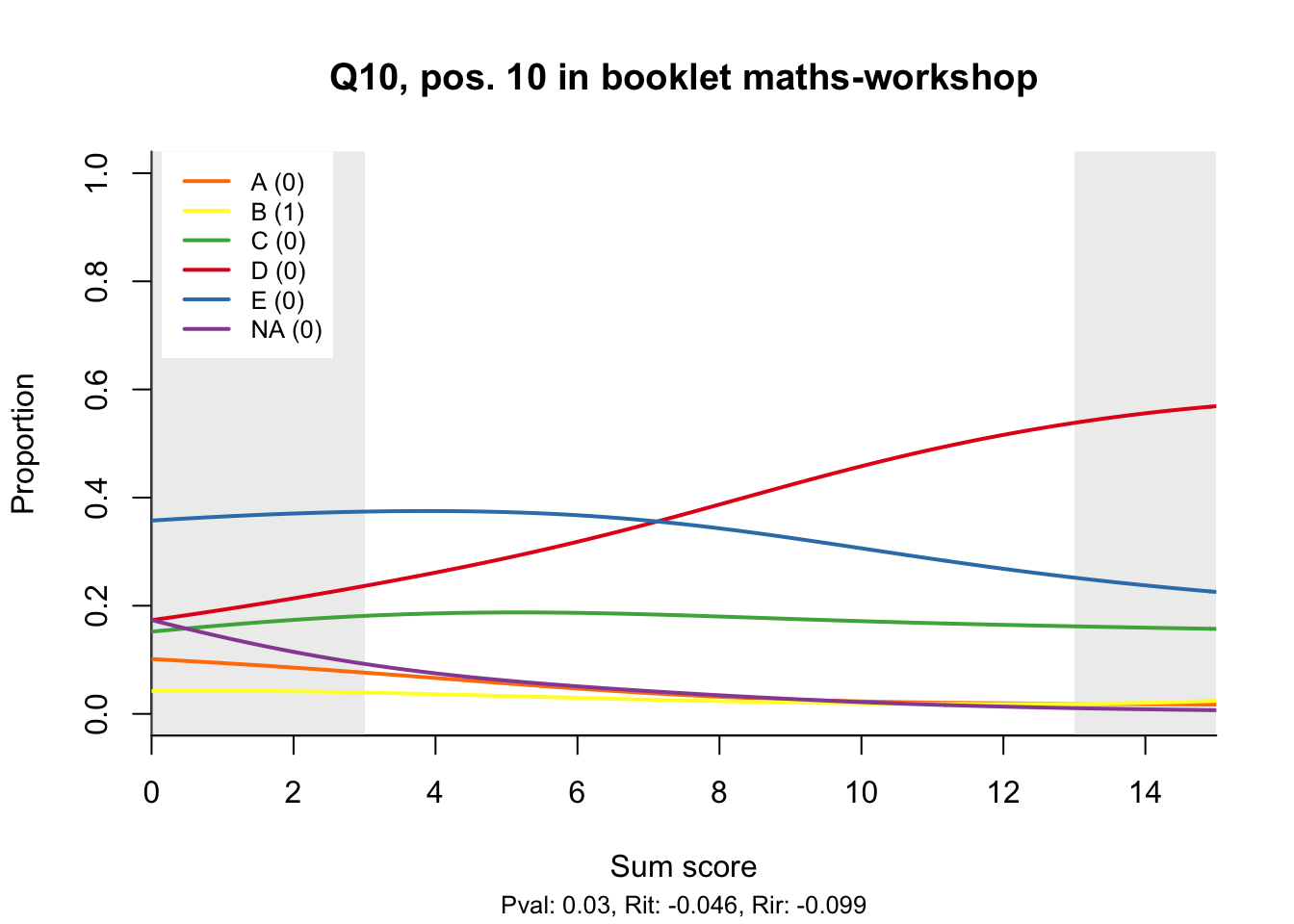
23.4 Rasch analysis
# run a traditional Rasch analysis using the item scores produced above
library(TAM)
# All the results of the Rasch analysis are stored in the object called "mod1"
mod1 <- TAM::tam.jml(item_scores)
summary(mod1)knitr::kable(mod1$item1)| xsi.label | xsi.index | xsi | se.xsi |
|---|---|---|---|
| Q1 | 1 | -2.1712756 | 0.0789443 |
| Q2 | 2 | -2.6145757 | 0.0903290 |
| Q3 | 3 | -1.9994327 | 0.0752989 |
| Q4 | 4 | 1.0888622 | 0.0611206 |
| Q5 | 5 | -0.6919299 | 0.0588426 |
| Q6 | 6 | 0.0268089 | 0.0566208 |
| Q7 | 7 | -0.6757986 | 0.0587454 |
| Q8 | 8 | -0.2557563 | 0.0569897 |
| Q9 | 9 | -0.3165510 | 0.0571532 |
| Q10 | 10 | 4.1437076 | 0.1610654 |
| Q11 | 11 | 0.1405420 | 0.0566530 |
| Q12 | 12 | -0.3135028 | 0.0571443 |
| Q13 | 13 | 0.0268089 | 0.0566208 |
| Q14 | 14 | 1.5975040 | 0.0670230 |
| Q15 | 15 | -0.1681469 | 0.0568066 |
summary(mod1$item1$xsi) Min. 1st Qu. Median Mean 3rd Qu. Max.
-2.61458 -0.68386 -0.25576 -0.14552 0.08367 4.14371 summary(mod1$theta) Min. 1st Qu. Median Mean 3rd Qu. Max.
-5.01490 -0.81791 -0.08508 0.00000 1.14240 5.59084 library(WrightMap)
wrightMap(mod1$theta, mod1$xsi, item.side = itemClassic) [,1]
[1,] -2.17127562
[2,] -2.61457572
[3,] -1.99943270
[4,] 1.08886221
[5,] -0.69192988
[6,] 0.02680892
[7,] -0.67579856
[8,] -0.25575627
[9,] -0.31655103
[10,] 4.14370761
[11,] 0.14054200
[12,] -0.31350278
[13,] 0.02680892
[14,] 1.59750398
[15,] -0.16814688
plot(mod1,items = c(1:10))....................................................
Plots exported in png format into folder:
/Users/chris/Documents/CM3/Plots
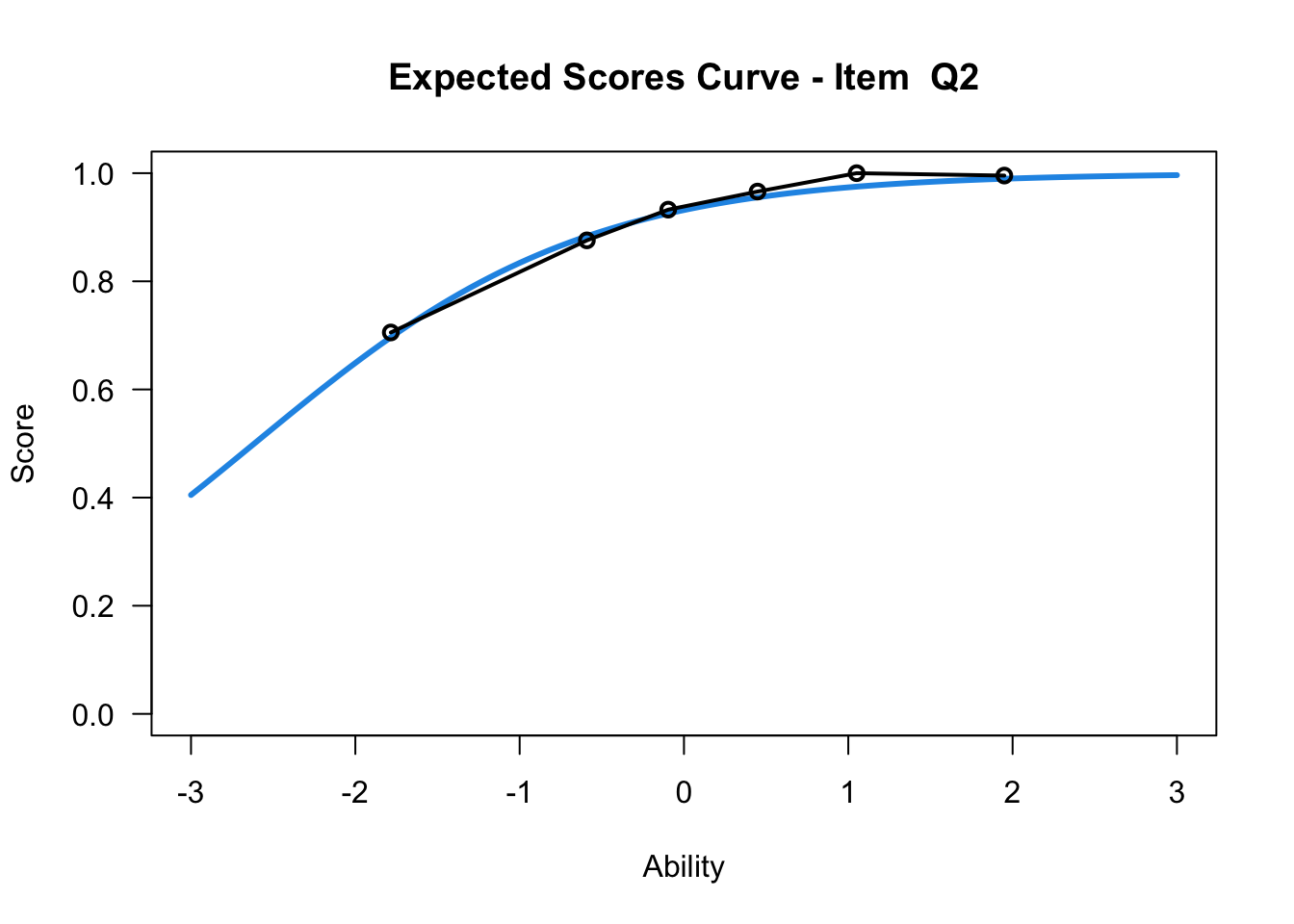
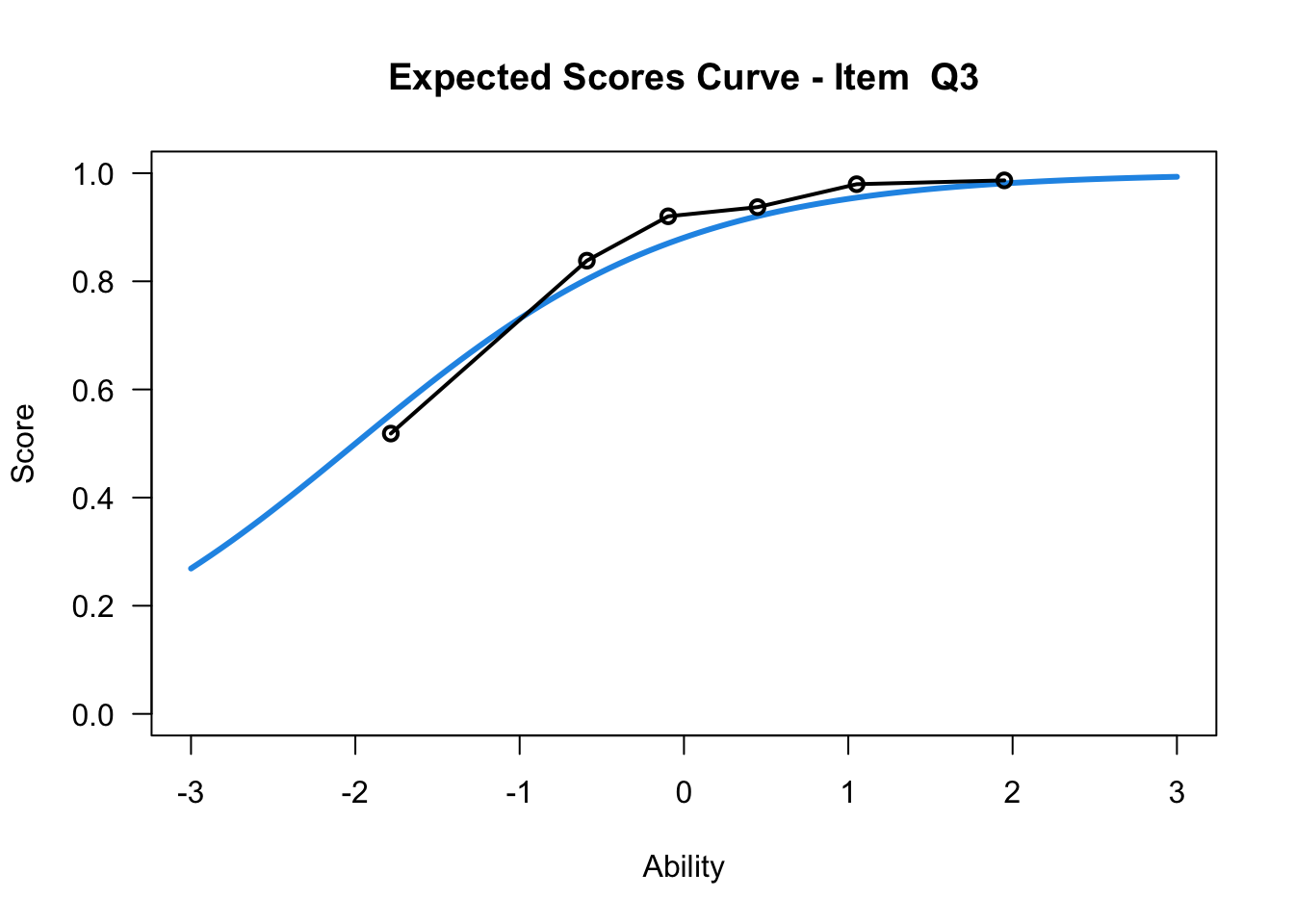
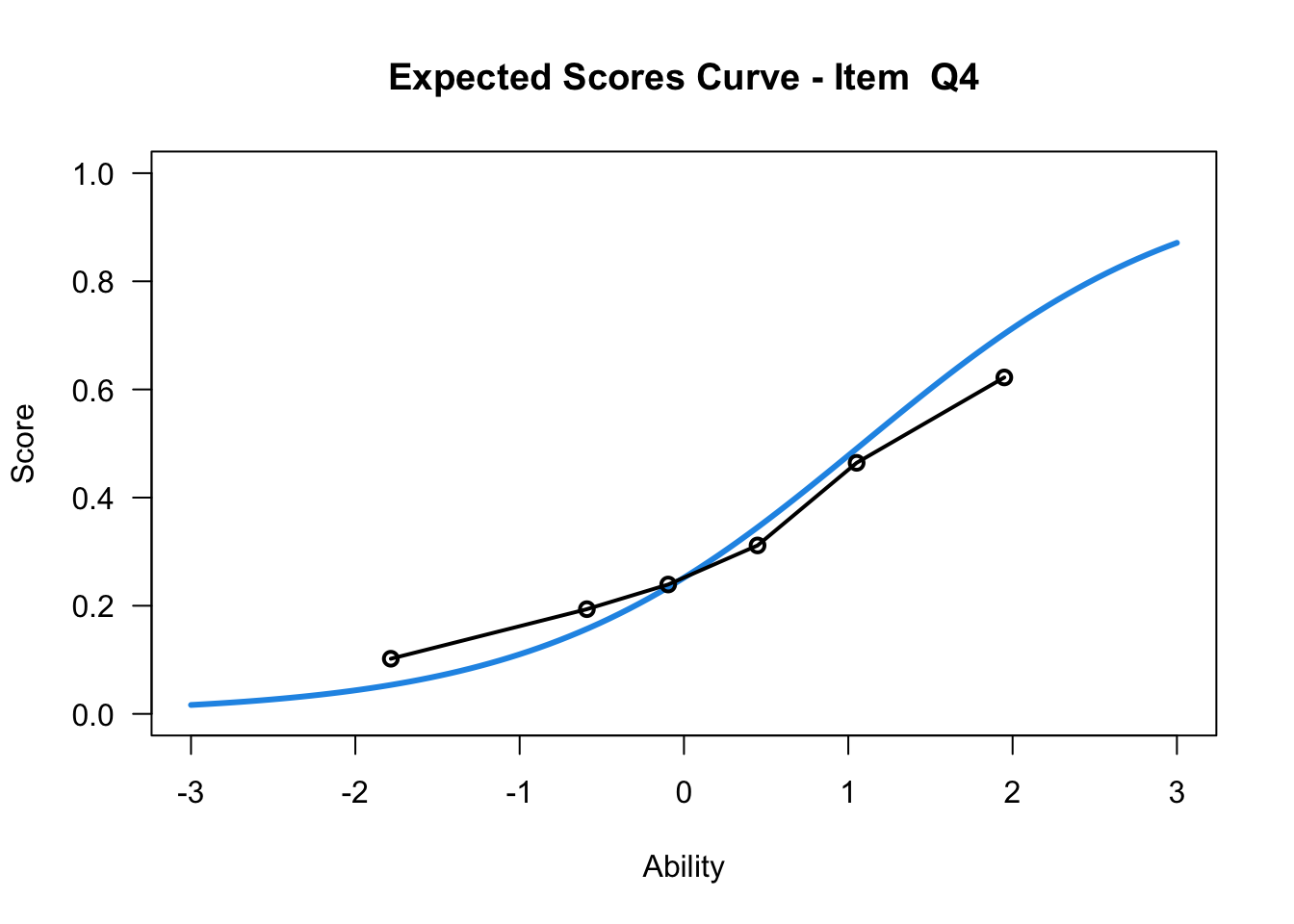

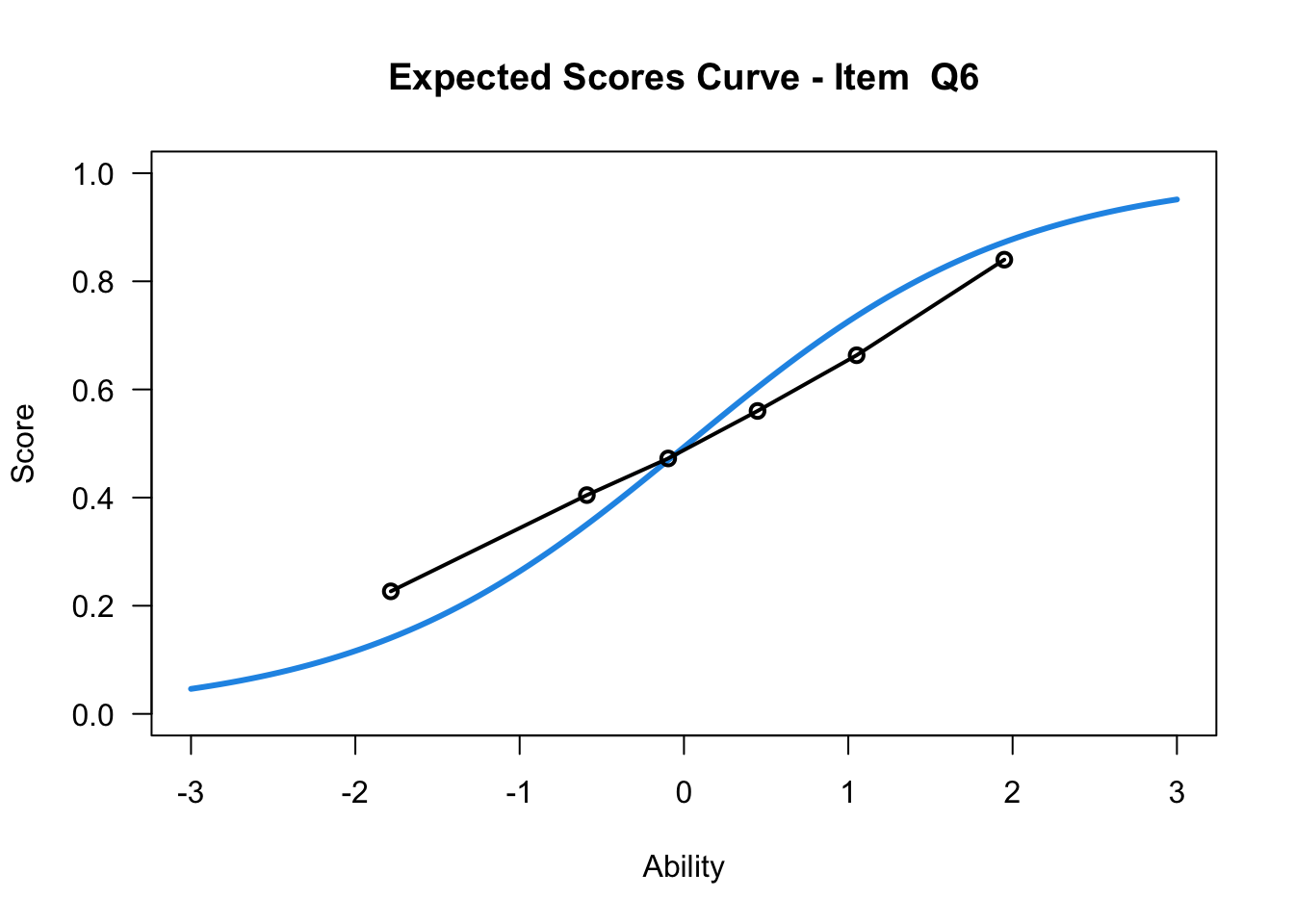
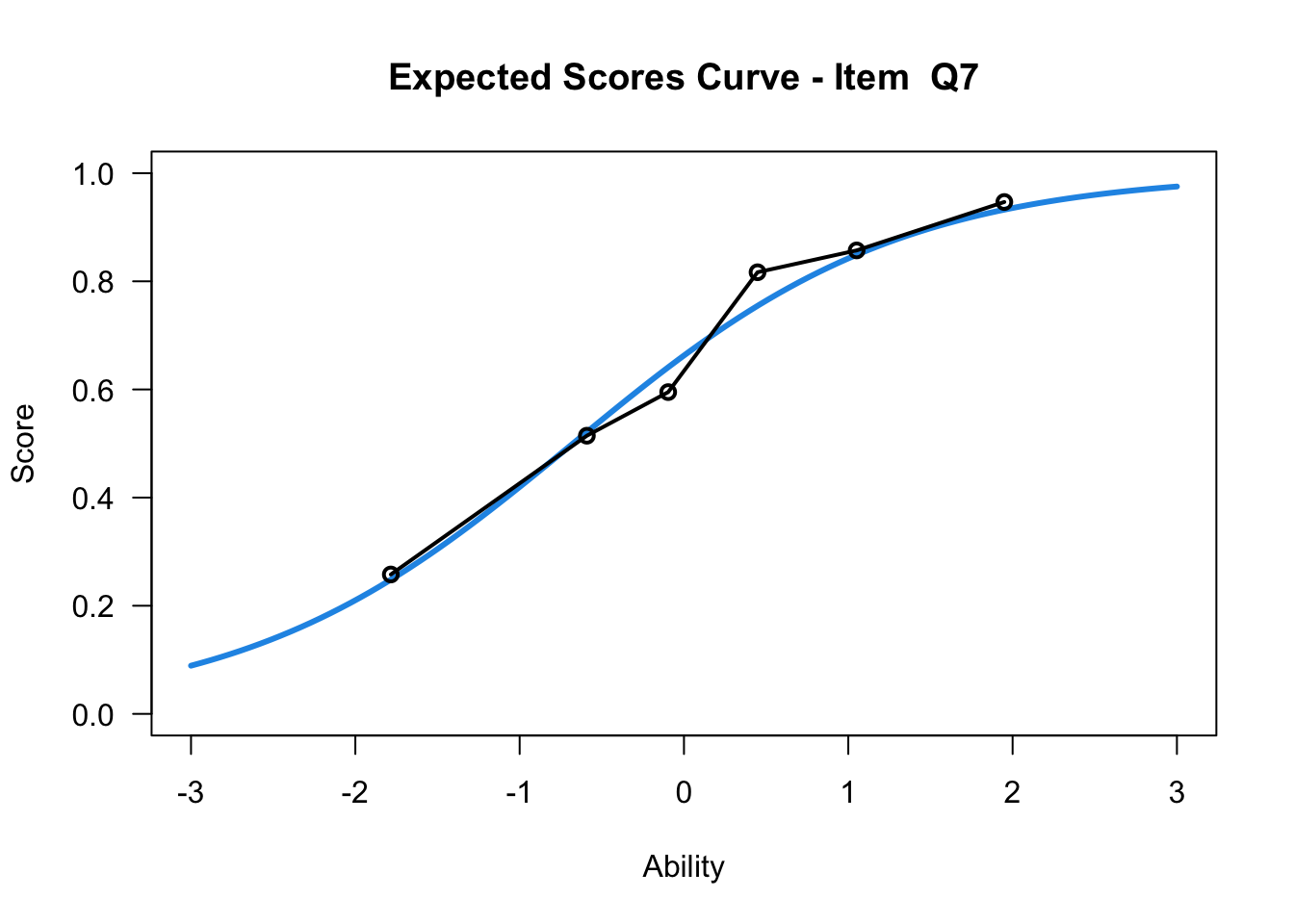
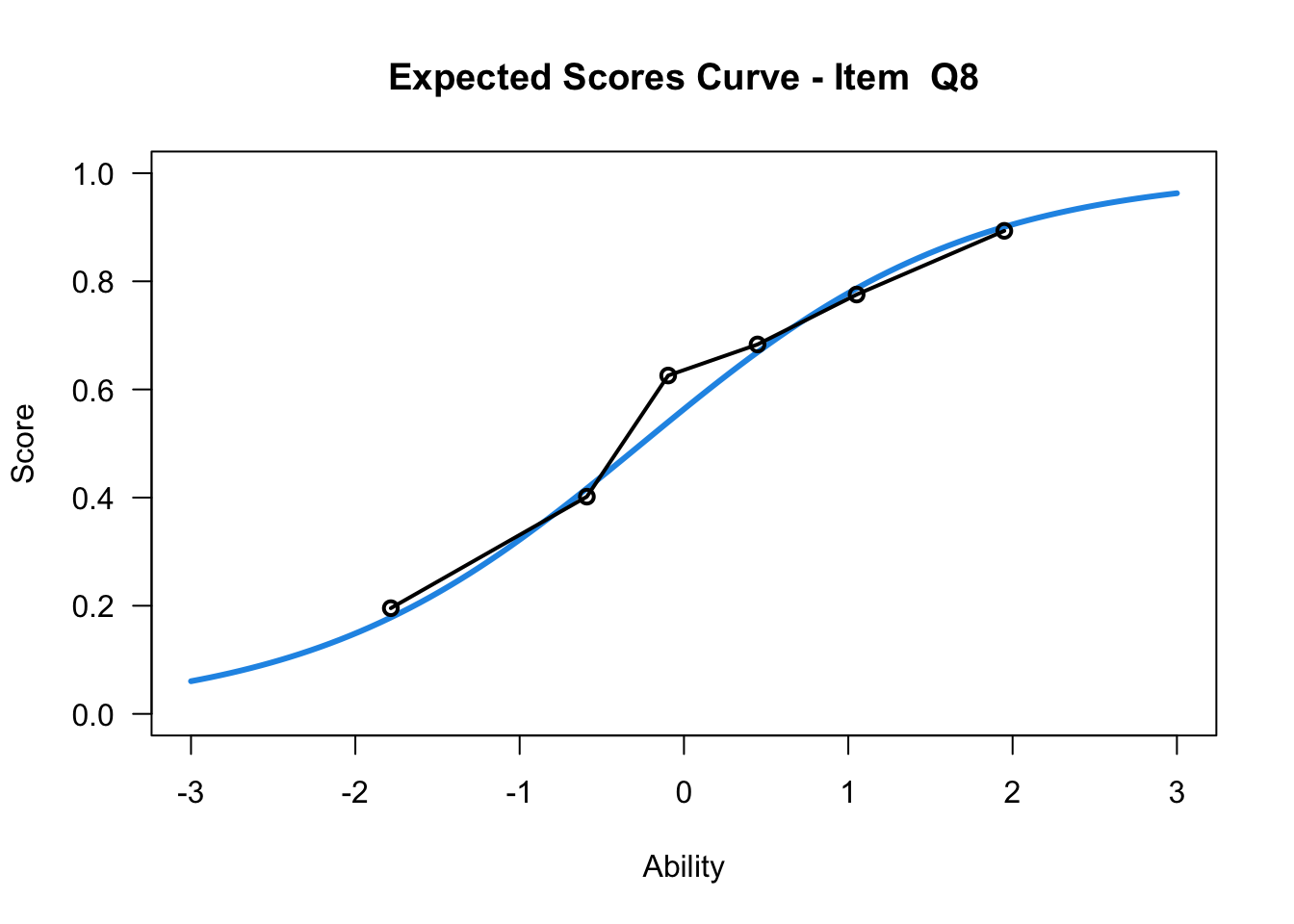
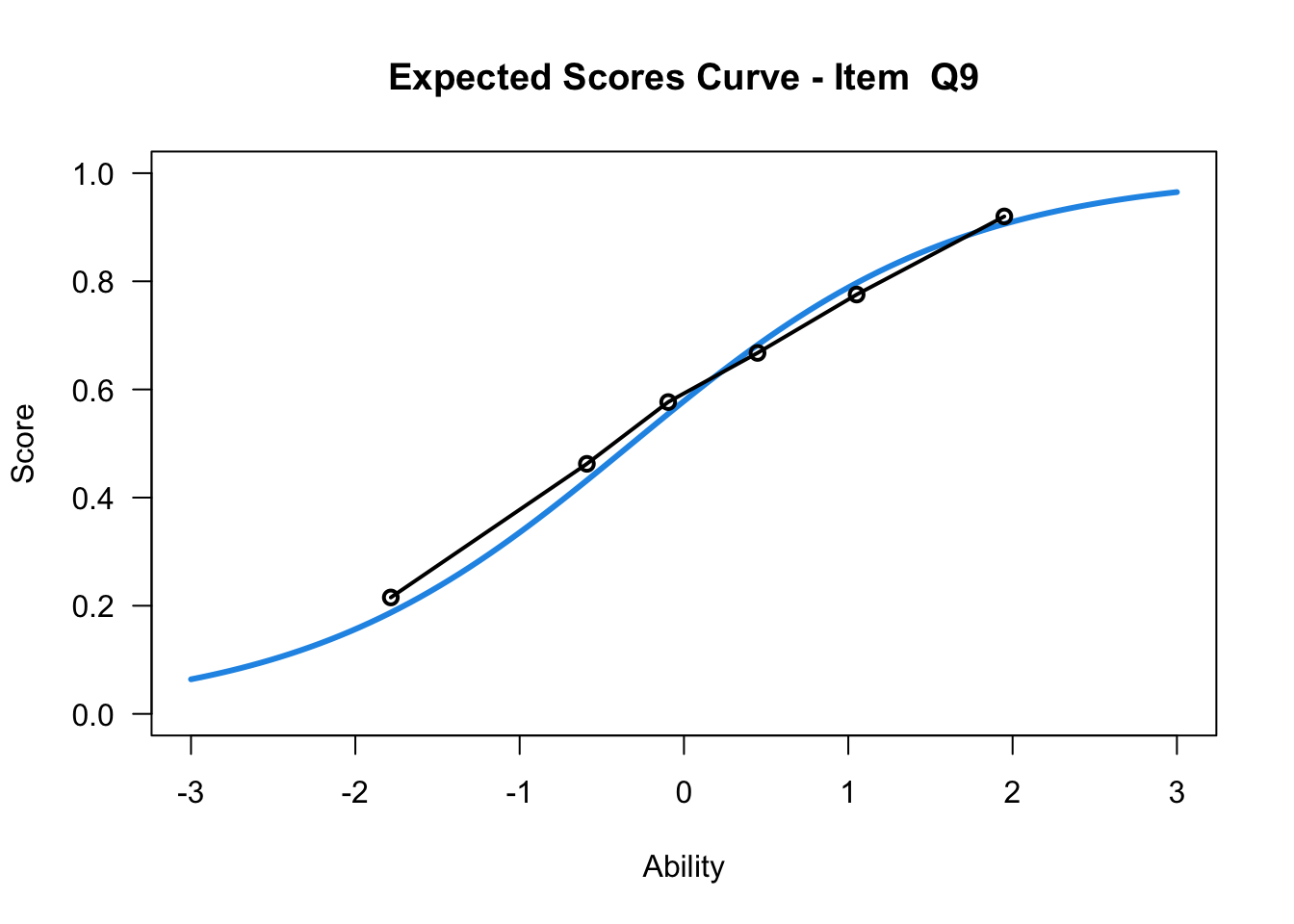
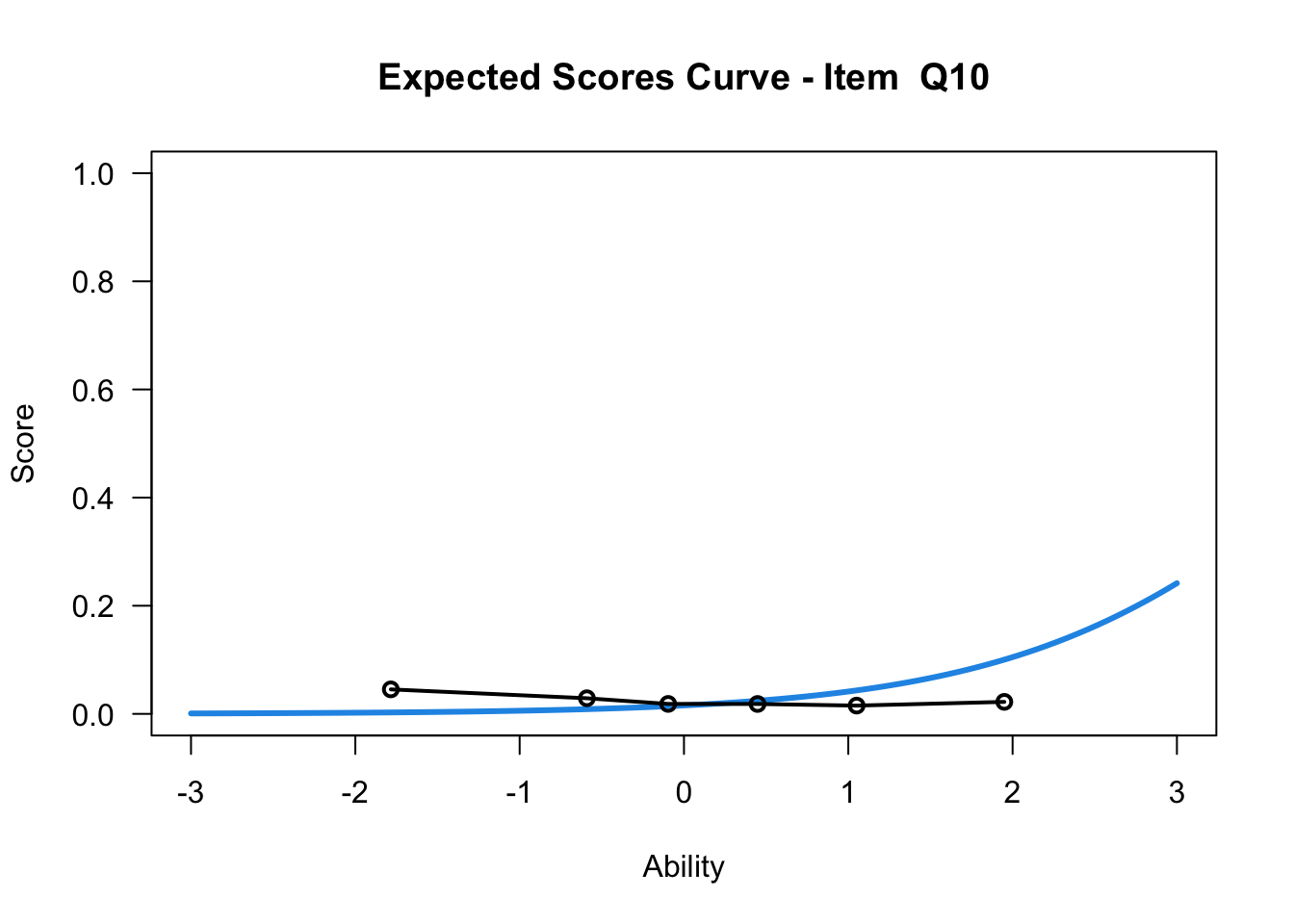
plot(mod1,items = c(10))....................................................
Plots exported in png format into folder:
/Users/chris/Documents/CM3/Plots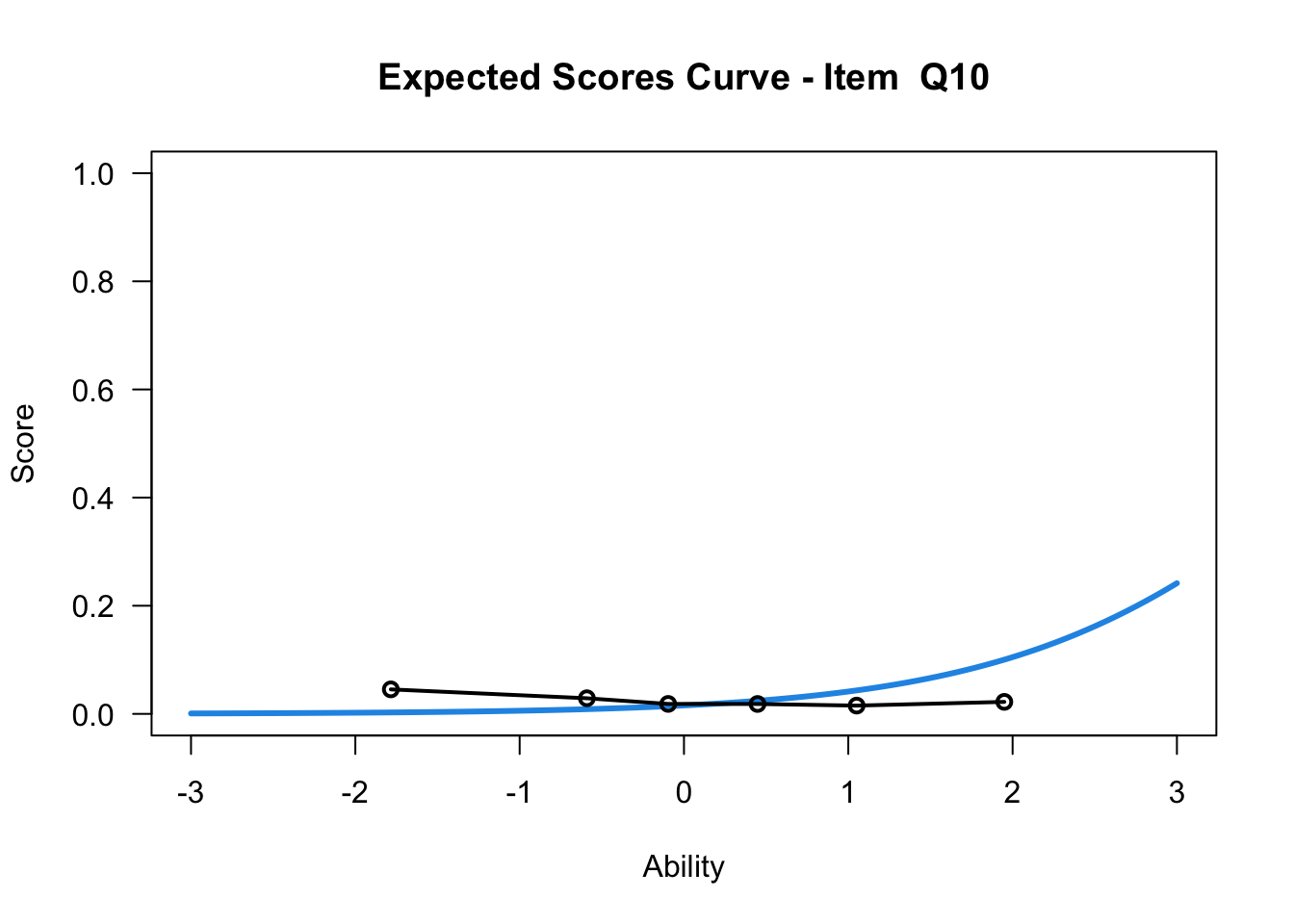
fit1 <- tam.jml.fit(mod1,trim_val = NULL)
item_fit <- tibble(fit1$fit.item)
item_fit <- item_fit %>% bind_cols(mod1$item1)
knitr::kable(item_fit, digits = 2)| item | outfitItem | outfitItem_t | infitItem | infitItem_t | xsi.label | xsi.index | xsi | se.xsi |
|---|---|---|---|---|---|---|---|---|
| Q1 | 0.81 | -1.66 | 0.88 | -2.58 | Q1 | 1 | -2.17 | 0.08 |
| Q2 | 0.70 | -2.24 | 0.86 | -2.63 | Q2 | 2 | -2.61 | 0.09 |
| Q3 | 0.77 | -2.26 | 0.86 | -3.51 | Q3 | 3 | -2.00 | 0.08 |
| Q4 | 1.16 | 2.11 | 1.09 | 3.23 | Q4 | 4 | 1.09 | 0.06 |
| Q5 | 0.92 | -1.37 | 0.98 | -0.76 | Q5 | 5 | -0.69 | 0.06 |
| Q6 | 1.21 | 3.84 | 1.14 | 5.78 | Q6 | 6 | 0.03 | 0.06 |
| Q7 | 0.91 | -1.55 | 0.97 | -1.23 | Q7 | 7 | -0.68 | 0.06 |
| Q8 | 1.00 | 0.06 | 1.01 | 0.44 | Q8 | 8 | -0.26 | 0.06 |
| Q9 | 1.04 | 0.75 | 1.04 | 1.65 | Q9 | 9 | -0.32 | 0.06 |
| Q10 | 5.43 | 6.42 | 0.95 | -0.35 | Q10 | 10 | 4.14 | 0.16 |
| Q11 | 0.74 | -5.57 | 0.81 | -8.65 | Q11 | 11 | 0.14 | 0.06 |
| Q12 | 0.91 | -1.78 | 0.97 | -1.34 | Q12 | 12 | -0.31 | 0.06 |
| Q13 | 0.92 | -1.55 | 0.95 | -2.31 | Q13 | 13 | 0.03 | 0.06 |
| Q14 | 1.43 | 3.96 | 1.06 | 1.85 | Q14 | 14 | 1.60 | 0.07 |
| Q15 | 0.80 | -4.19 | 0.87 | -5.75 | Q15 | 15 | -0.17 | 0.06 |
Item Fit Statistics
# plot the item infit against the item difficulty
p <- ggplot(item_fit, aes(x=infitItem, y=xsi, size=se.xsi,label=item))
p <- p + geom_point()
p <- p + geom_text(data=item_fit %>% filter(infitItem>1.1),aes(x=infitItem, y=xsi,label=item,size=4),nudge_y=0.15, nudge_x = -0.005)
print(p)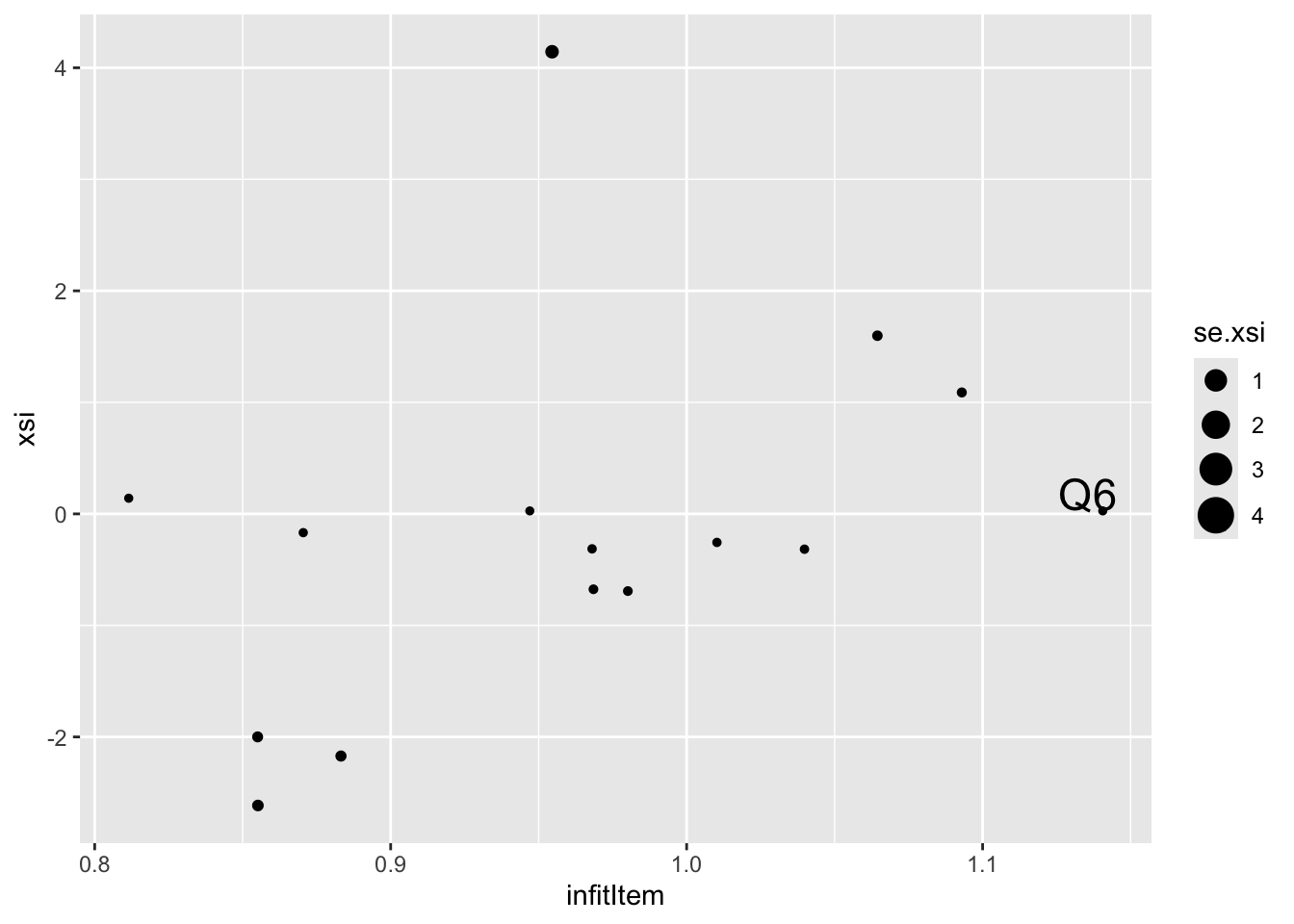
# plot the item outfit against the item difficulty
p <- ggplot(item_fit, aes(x=outfitItem, y=xsi, size=se.xsi,label=item))
p <- p + geom_point()
p <- p + geom_text(data=item_fit %>% filter(outfitItem>1.1),aes(x=outfitItem, y=xsi,label=item,size=4),nudge_y=0.15, nudge_x = -0.005)
print(p)
23.5 DIF
item_scores <- item_scores %>% mutate(gender = responses$gender)
long_responses <- item_scores %>% pivot_longer(cols = Q1:Q15, names_to = "question", values_to = "score")
long_responses <- long_responses %>% mutate(gender = factor(gender))
long_responses <- long_responses %>% mutate(question = factor(question))
response_summary <- long_responses %>%
group_by(gender, question) %>%
summarise(mean_score = mean(score,na.rm=TRUE))`summarise()` has grouped output by 'gender'. You can override using the
`.groups` argument.question_difficulty <- response_summary %>%
filter(gender=='F') %>%
arrange(mean_score) %>% pull(question)
ordered_responses <- response_summary %>% mutate(item = factor(question, levels=question_difficulty, ordered=TRUE))
ordered_responses <- ordered_responses %>% mutate(
gender = factor(gender)
)
p <- ggplot(ordered_responses, aes(x=item, y=mean_score, group=gender, colour=gender, line_style=gender))
p <- p + geom_line() # rotate the x-axis labels
p <- p + theme_light()
p <- p + theme(axis.text.x = element_text(angle = 90, hjust = 1))
p